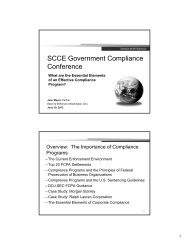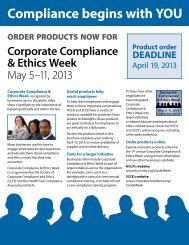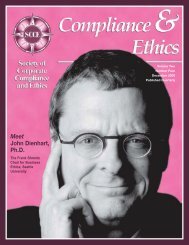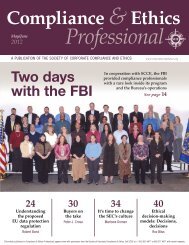Compliance &Ethics - Society of Corporate Compliance and Ethics
Compliance &Ethics - Society of Corporate Compliance and Ethics
Compliance &Ethics - Society of Corporate Compliance and Ethics
- No tags were found...
Create successful ePaper yourself
Turn your PDF publications into a flip-book with our unique Google optimized e-Paper software.
<strong>Compliance</strong> & <strong>Ethics</strong> Pr<strong>of</strong>essional May/June 2013Every symptom suggests the need foraction. The danger is that, unless we systematically<strong>and</strong> systemically develop “causal” data,we risk develop a string <strong>of</strong> serial actions thatare unconnected <strong>and</strong> will lack the impact weneed on the root problem.Systems Theory helps us underst<strong>and</strong> <strong>and</strong>employ our underst<strong>and</strong>ing <strong>of</strong> the interconnectedness<strong>of</strong> thevarious aspects <strong>of</strong>organizations <strong>and</strong>thus the inherentinterrelatedness <strong>of</strong>the data we gatherabout those organizations.Systems Theoryspeaks to root causes.Diagnosis basedon a “systemic”underst<strong>and</strong>ing <strong>of</strong>your organization isjust as critical for youas it was for me to underst<strong>and</strong> the connectionbetween oil pressure <strong>and</strong> valve wear. Systemicthinking allows us to underst<strong>and</strong> the “why”behind the “what.” It shines a light on thecauses behind the symptoms.Perhaps the most powerful systems model<strong>of</strong> organizational inter-relatedness was publishedin 1982, by David Nadler, 2 who referredto his Organization Performance Model (OPM)as a framework for organizational behavior.My first exposure to the OPM was as part <strong>of</strong> a45-person team <strong>of</strong> internal consultants formedin 1982 to help guide what was then knownas the Bell System through the largest organizationalrestructuring in modern history: thedismantling <strong>of</strong> the one-million employee BellSystem <strong>and</strong> the simultaneous creation <strong>of</strong> sevenBell Operating Companies, along with anindependent AT&T <strong>and</strong> Western Electric. Oneobserver <strong>of</strong> that day (January 1, 1984) characterizedit as the equivalent <strong>of</strong> disassembling afully loaded 747, in flight, <strong>and</strong> creating sevenDiagnosis provides data.Models… provide systemicconstructs that allow us toanalyze the inter-relatednesswithin <strong>and</strong> between the dataelements <strong>and</strong> underst<strong>and</strong>what they mean.707s from the parts, with each <strong>and</strong> every passengerarriving at their designated destination,on time, with their luggage in h<strong>and</strong>.Nadler’s OPM suggested that the key toorganizational success was “congruence,” the“fit” within <strong>and</strong> between the various components<strong>of</strong> an organization <strong>and</strong> the contextwithin which the organization operates. Hetalked about environment,resources,history, strategy,mission, vision,values, the taskspeople performed,<strong>and</strong> the people performingthem. All<strong>of</strong> this was donein the context <strong>of</strong>both the formal <strong>and</strong>informal organizationalsystems.And it producedorganizational outcomes, group outcomes <strong>and</strong>individual outcomes. Finally, the system wasinformed by feedback mechanisms within <strong>and</strong>between all <strong>of</strong> the above.Diagnosis provides data. Models, suchas the OPM, provide systemic constructsthat allow us to analyze the inter-relatednesswithin <strong>and</strong> between the data elements <strong>and</strong>underst<strong>and</strong> what they mean. Absent such acoherent model, the data can be just an overwhelmingmass <strong>of</strong> information, lacking utility.ConclusionYou can solve only the problems you knowyou are facing. The most visible aspect <strong>of</strong> anyproblem is what medicine refers to as the “presenting”symptom(s). But symptoms are justthat—“…a departure from normal function orfeeling which is noticed by a patient, indicatingthe presence <strong>of</strong> disease or abnormality.A symptom is subjective, observed by thepatient, <strong>and</strong> cannot be measured directly.” 364 www.corporatecompliance.org +1 952 933 4977 or 888 277 4977
















